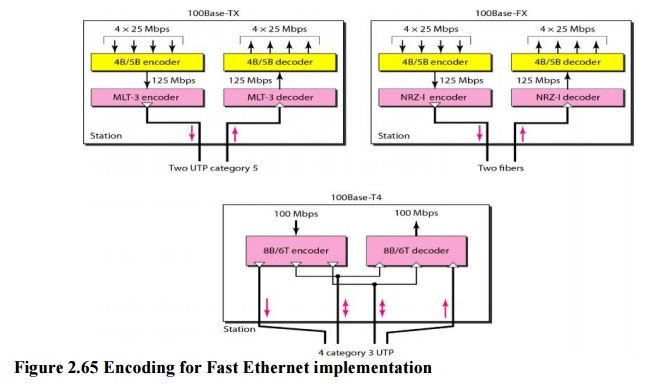Chapter: Computer Networks : Data Link Layer
Fast Ethernet
Fast Ethernet
Fast
Ethernet was designed to compete with LAN protocols such as FDDI or Fiber
Channel. IEEE created Fast Ethernet under the name 802.3u. Fast Ethernet is
backward-compatible with Standard Ethernet, but it can transmit data 10 times
faster at a rate of 100 Mbps. The goals of Fast Ethernet can be summarized as
follows:
1. Upgrade
the data rate to 100 Mbps.
2. Make it
compatible with Standard Ethernet.
3. Keep the
same 48-bit address.
4. Keep the
same frame format.
5. Keep the
same minimum and maximum frame lengths.
1. MAC Sublayer
A main
consideration in the evolution of Ethernet from 10 to 100 Mbps was to keep the
MAC sublayer untouched. However, a decision was made to drop the bus topologies
and keep only the star topology. For the star topology, there are two choices,
as we saw before: half duplex and full duplex. In the half-duplex approach, the
stations are connected via a hub; in the full-duplex approach, the connection
is made via a switch with buffers at each port.
2. Implementation
Fast
Ethernet implementation at the physical layer can be categorized as either
two-wire or four-wire. The two-wire implementation can be either category 5 UTP
(100 Base-TX) or fiber-optic cable (100Base-FX). The four-wire implementation
is designed only for category 3 UTP (l00Base-T4).

3. Encoding
Manchester
encoding needs a 200-Mbaud bandwidth for a data rate of 100 Mbps, which makes
it unsuitable for a medium such as twisted-pair cable. For this reason, the
Fast Ethernet designers sought some alternative encoding/decoding scheme.
However, it was found that one scheme would not perform equally well for all
three implementations.
a. 100 Base-TX uses two pairs of twisted-pair
cable (either category 5 UTP or STP). Forthis implementation, the MLT-3 scheme
was selected since it has good bandwidth performance. However, since MLT-3 is
not a self-synchronous line coding scheme, 4B/5B block coding is used to
provide bit synchronization by preventing the occurrence of a long sequence of
0s and 1s. This creates a data rate of 125 Mbps, which is fed into MLT-3 for
encoding

b. 100 Base-FX uses two pairs of fiber-optic
cables. Optical fiber can easily handle highbandwidth requirements by using
simple encoding schemes. The designers of 100Base-FX selected the NRZ-I
encoding scheme for this implementation. However, NRZ-I has a bit
synchronization problem for long sequences of 0s.
c. A 100
Base-TX network can provide a data rate of 100 Mbps, but it requires the use of
category 5 UTP or STP cable. This is not cost-efficient for buildings that have
already been wired for voice-grade twisted-pair (category 3). A new standard,
called 100Base-T4 was designed to
use category 3 or higher UTP.
Related Topics